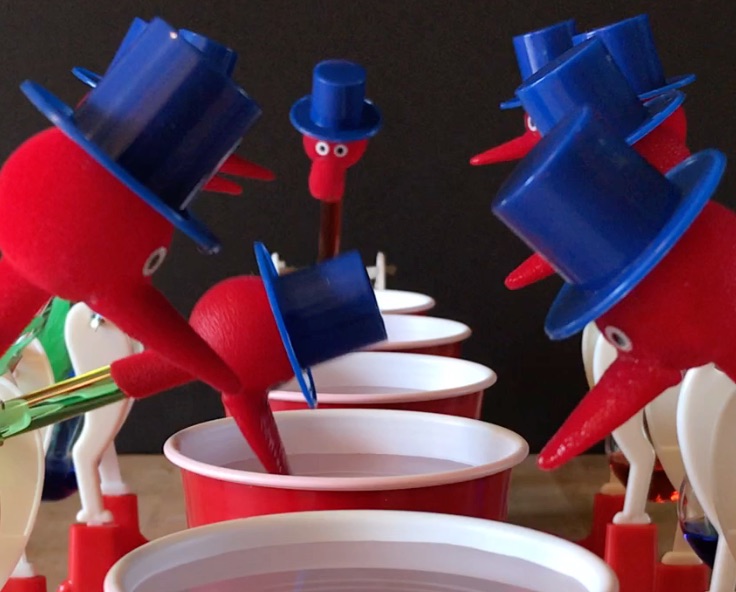The Gravity Light
Description: The Gravity Light converts potential energy that is stored in a weight into light. The principles involved in this design are very similar to the principles in a cuckoo clock, with the potential energy of the weight being converted to solar energy rather than kinetic energy. Gravity Lights can replace kerosene lights in the developing world with a safe alternative. The phenomenon can be used to illustrate the conversion of potential gravitational energy into other forms of energy. More importantly it conveys the message of sustainability and social responsibility.
Web Resource: The Gravity Light - Wikipedia, The Gravity Light Foundation
Amazing Rube Goldberg Machines
Description: Rube Goldberg machines are named after American cartoonist Rube Goldberg who drew complicated steps involved in doing a fairly simple task (like pouring milk in a glass). Students can study these machines, or build their own, to show how energy can be converted through a series of interactions. In lower elementary classes they might be shown or built to show how pushes or pulls can change the motion of objects. As they move through school they should start to identify specific collisions, interactions, and conversions of energy.
Web Resources: Rube Goldberg Machines - Wikipedia
Candle-Powered Car
Description: The candle-powered car is an application of the Seebeck Effect. This effect is the result of thermal energy conversion directly into electricity. This phenomenon can be used in elementary school to show energy conversion from heat to electricity to the kinetic energy of the car. A more detailed explanation will be required in high school related to electron response to temperature differences in different materials. The Seeback circuit used in this candle-powered car can also be connected to a voltmeter and used as a temperature sensing thermocouple.
Web Resource: Seebeck Effect, Candle Car Kit - Amazon
The Visual Microphone: Passive Recovery Of Sound From Video
Description: In this amazing demonstration researchers are able to extract audio from the video of an object (a plant, an empty bag, etc.) in the same room as the sound. The sound waves vibrate the object which is made visible through tiny movements processed with a graphic algorithm. This could be used as a phenomenon in a unit on sounds, waves, and information.
Web Resource: Extracting audio from visual information - MIT News
Solar Cars
Description: Solar cars use energy from the sun and photovoltaic cells to transport humans. Large solar cars are generally built by universities to compete in solar car races but mini-solar cars can be built in any science classroom. The photovoltaic cells convert solar energy into electricity which runs an electric motor. Energy conversion can be studies within the unit and a solar car design challenge can be used as a culminating design challenge. The criteria and constraints can be modified to the age of the students in the class.
Web Resource: Solar Car - Wikipedia
Shatter A Wine Glass With Your Voice
Description: You can shatter a wine glass with your voice but it isn't easy. The pitch must match the natural frequency of the glass and the volume must be high enough t0 physically vibrate the glass. The video below documents how long it takes Mike Boyd to achieve this task. Most students understand that vibrating materials create sound but they don't realize that the opposite is true as well.
CAUTION: When the glass breaks tiny shards of glass can enter your eye and so eye protection should always been warn when attempting this phenomenon.
Web Resource: Fact or Fiction?: An Opera Singer's Piercing Voice Can Shatter Glass - Scientific American
Giant Newton's Cradle
Description: The coupled pendulum can be created with either string or a spring connecting the two pendulums. With each swing energy is transferred from one pendulum to the other. If the pendulums both have the same length one pendulum comes to a complete stop before alternating motion. This phenomenon can be used to show balanced and unbalanced forces, how motion can be used to predict future motion, and the conservation of energy.
Web Resources: Giant Newton’s Cradle Website, Wikipedia article
The Drinking Bird
Description: The drinking bird is a toy heat engine. The source of energy in this phenomenon is a mystery to most students. It is said that Albert Einstein and his wife Elsa were fascinated with this toy when they visited Shanghai in the 1920's.
Web Resources: The Engineering of the Drinking Bird, The Drinking Bird - Wikipedia










